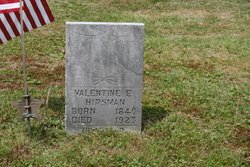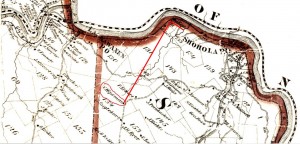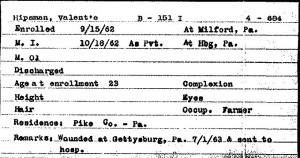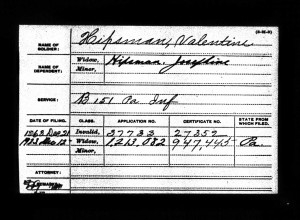The Great Shohola Train Wreck – Valentine Hipsman, Witness to the Exhumation of Bodies in 1911
Posted By Norman Gasbarro on June 27, 2014
In 1911, the United States Government approved the removal of the bodies of the victims of the Great Shohola Train Wreck, Pike County, Pennsylvania, from the site of the wreck to the Woodlawn National Cemetery in Elmira, New York. Official documents related to the re-interment were presented here in the blog post entitled, Moving the Remains from Shohola to Elmira in 1911.
The above cut from an 1872 map of Pike County, can be enlarged (click on map) to show the location of the wreck and the properties of the two local men who contributed to finding the actual burial site. In the center of the map (circled in red) is the property of “V. Hipsman” (Valentine Hipsman). From his home a red line is drawn slightly northeast to the site of the wreck and the property of “J. Vogt” (John Vogt). It was on the property of John Vogt that the original interment took place. In an article that appeared in the Honesdale Citizen, 3 November 1909, it was reported that the bodies were buried on Vogt’s property. Vogt disputed the contention of Edward H. Mott who wrote in Between the Ocean and the Lakes, that some of the bodies had been washed away by floods on the Upper Delaware, and that he [Vogt] had personally placed stakes at the ends of the burial trench. According to Vogt, “the bodies [were] still there.” The Citizen article went on to state that it was “Valentine Hipsman, a veteran, who had lost an arm in the war,” who led visitors to the site by walking the mile-and-a-half from the village of Shohola, where he was then living.
While John Vogt, a track foreman for the Erie Railroad, was not an actual witness to the wreck itself, he claimed to have heard the sounds of the crash, and immediately headed to the scene offering what assistance he could including the use of his home as an emergency hospital.
Valentine Hipsman, whose home in 1864 was less than two miles from the wreck site, was the individual who led the workers to the burial site in 1911 when the bodies were exhumed and removed to Elmira. It is a matter of speculation as to whether he was at his home in July 1864 when the wreck occurred (see below).
By 1909, both John Vogt and Valentine Hipsman were living in the village of Shohola.
Some personal information about Valentine Hipsman can be gleaned from his death certificate (above, from Ancestry.com). He was born in Germany on 2 January 1840, the son of George F. Hipsman and Elizabeth [Weisenborn] Hipsman. He was a farmer. He died in Shohola at the age of 83 years, 10 months, 7 days on 9 November 1923 of vascular disease of the heart caused by hardening of the arteries. At the time of his death, he was married.
At the time of the 1863 Civil War Draft (see above from Ancestry.com), Valentine registered from his home address in Shohola [Township]. He was 23 years old, married, and gave his occupation as laborer. He did not indicate at that time that he had prior military service. The record card from the Pennsylvania Archives (see below) shows otherwise.
Valentine had enrolled on 15 September 1862 at Milford, Pike County, Pennsylvania, and on 18 October 1862, he was mustered into Company B, 151st Pennsylvania Infantry, as a Private at Harrisburg. His occupation was farmer, but other than his age, no other personal information about him is found in this record. As for the remarks about his service, it is noted that he was “wounded at Gettysburg, Pennsylvania, 1 July 1863, and sent to [the] hospital.”
The nature of his wounds were apparently sufficient to give him a discharge on a Surgeon’s Certificate of Disability, but that fact is not noted on the card – nor is the date on which he was discharged.
The pension application date of 21 December 1863 (shown on the card above, from Ancestry.com) is proof that Valentine had been released from the hospital as of that date – and was most likely at his Pike County home (see map at top of post) when the wreck occurred on 15 July 1864. However, no “eyewitness” account has been seen where Hipsman describes what he was doing on that date or whether he heard the sounds of the wreck from his property. It is very likely that full details of the nature of his injures can be found in the pension application file which is available at the National Archives.
In the 1890 Census of Veterans and Widows (cuts shown above from Ancestry.com), Valentine gave his date of discharge at 27 July 1863 and the nature of his injury as “loss of right arm (shoulder).” In that the discharge took place only 26 days after he was wounded at Gettysburg, probably meant that he returned to his home and wife shortly after – and could mean that he was at his home about a year later when the wreck occurred.
In the 1870 census, Valentine Hipsman was a “switch tender” for the railroad. His wife, Elizabeth Hipsman, age 27, was in the household with children Emma E. Hipsman (born about 1867), Margaret “Maggie” Hipsman (born about 1868), and Josephine Hipsman (born about 1869).
By the 1880 census, Valentine was a farmer and had re-married to Josephine Keller, age 40, who had been previously married and had at least 3 children by that marriage who were then living in Valentine’s household: Frank Keller; Justina Keller; and Carrie Keller. Two additional children were in the home: Bertha Hipsman (born about 1876) and Catherine Hipsman (born about 1878). It is not clear whether the latter two were children of Elizabeth or Josephine with Valentine.
By the 1900 census, Josephine is still the wife of Valentine and he is working as a farmer. Josephine is the widow who survived Valentine as shown by the Pension Index Card (above).
Much more information on Valentine Hipsman can be obtained by utilizing the Pension Application Files as well as the Military Index Cards available at the National Archives. Those sources were not consulted for this blog post.
It is ironic that five key sites in the life of Valentine Hipsman were in Pennsylvania: Shohola Township, where his farm was located; Harrisburg, where he was mustered into service in the 151st Pennsylvania Infantry; Gettysburg, where he was wounded and lost his arm; the site of the Great Shohola Train Wreck about 1.5 miles from the village of Shohola; and the village of Shohola, where he spent his last days. The Civil War played such an important part of the full life of this German immigrant – with constant reminders in both his physical condition and geographic location.

Valentine Hipsman is buried at German Hill Cemetery, Pike County, Pennsylvania, not far from where he lived and worked For further information, see his Findagrave memorial.
He is also forever remembered on the plaque of the 151st Pennsylvania Infantry, Company B, at the Pennsylvania Memorial at Gettysburg.
More information is sought on this veteran who led the government officials to the site of the wreck in 1911 thus participated in the exhuming of the bodies of the victims and their re-interment at Elmira. Because he lived to 1923 and had a number of children, it is possible that somewhere a picture exists of him and/or his family. Readers are invited to submit information by adding comments to this post or by sending a e-mail to the Project.
—————————
For a listing of all other posts in this series, with direct links, click on ShoholaTrainWreck. Special thanks to Jane Butler, Minisink Valley Genealogy, for the link to her recent article, “An Imperishable Fame” – Company B, 151st Pennsylvania Volunteers and for the direct URL to the 1909 article which appeared in the Honesdale Citizen.
 ;
;






Col. William Elliott, a Commissioner to “Mark Confederate Graves,” interviewed Mr. Hipsman in Shohola June 19, 1906. Mr. Hipsman stated that he was working on track repair at time of collision and Erie assigned him to help at the crash site. He also advised that he helped one prisoner named Patrick Henry Segoe, 8th NC infantry, escape and gave Elliott Segoe’s address in Lylesville, NC. The two corresponded until Elliott passed in 1908, with Segoe furnishing much information. He became a Baptist Minister in 1880 and built his own church in Lylesville that still stands. The State of NC also sought information from Segoe after Col. Elliott advised it of Segoe’s survival. However, NC denied him a veteran’s pension in 1912 on the grounds that he had been killed in the wreck. Segoe died in 1916. SOURCE: “Commission to Mark the Graves of Confederate Soldiers, Sailors, and Civilians Who Died at Northern Prison Camps During the Civil War. 13 Boxes. National Archives.